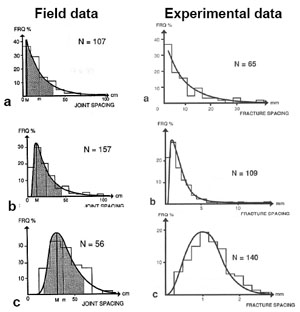| |||||||
|
|
|||||||
|
|
|||||||
| Joint Spacing Distribution | |||||||
|
Geologists have long been curious about the forms of joint spacing distributions in the field and their significance in terms of formation and evolution of joint systems especially for layered sedimentary rocks. The field data suggest various forms of joint spacing distributions which can be fitted to one of the three common forms (Figure 1) as summarized by Rives et al. (1992 p. 925-926): negative exponential, log-normal, and normal distributions. For example, Narr and Suppe (1991) proposed log-normal spacing (normalized by the median values) for joints measured in various lithologies in the Monterey Formation in coastal southern California at various sites. Some other studies proposed joint spacing is strongly dependent on lithology and the elastic properties of both stiff rocks in which the fractures occur as well as soft rocks surrounding the fractured rocks ((Ladeira and Price, 1981).
Analog studies using experimental materials made a large impact on our understanding of the geometry of joint arrays and the factors influencing the properties of the arrays such as the distribution of lengths of joints forming the array and their spacing. Rives et al. (1992) used polystyrene plates subjected to pure bending and Wu and Pollard (1991, 1995) used brittle coating on a polymethyl methacrylate substrate subjected to four point loading. These authors identified three stages of development with characteristic forms of distributions: from a negative exponential, to log-normal, and eventually to normal distribution corresponding to a poorly developed set through to fully developed joint sets (Figure 2). They also proposed that such evolution is due primarily to joint interactions. Initially, the fractures are short and sparse and their spacing is governed by a random process. With increasing fracture density, the fracture interaction and shadow zones of longer fractures become more important. These results suggest that the joint spacing distribution is a good indicator of how well developed a joint set is. Wu and Pollard also showed a non-linear decreasing relationship between spacing and strain magnitude. The plots apparently approach successively greater asymptotes of constant spacing for greater layer thicknesses. More on this topic can be found in 'Joint Spacing - Layer Thickness Scaling.' | |||||||
| Reference: |
|||||||
| Rives, T., Razack, M., Petit, J.P., Rawnsley, K.D., 1992 Wu, H., 1993 Wu, H., Pollard, D.D., 1995 |
|||||||
|
Readme | About Us | Acknowledgement | How to Cite | Terms of Use | Ⓒ Rock Fracture Knowledgebase |
|||||||

